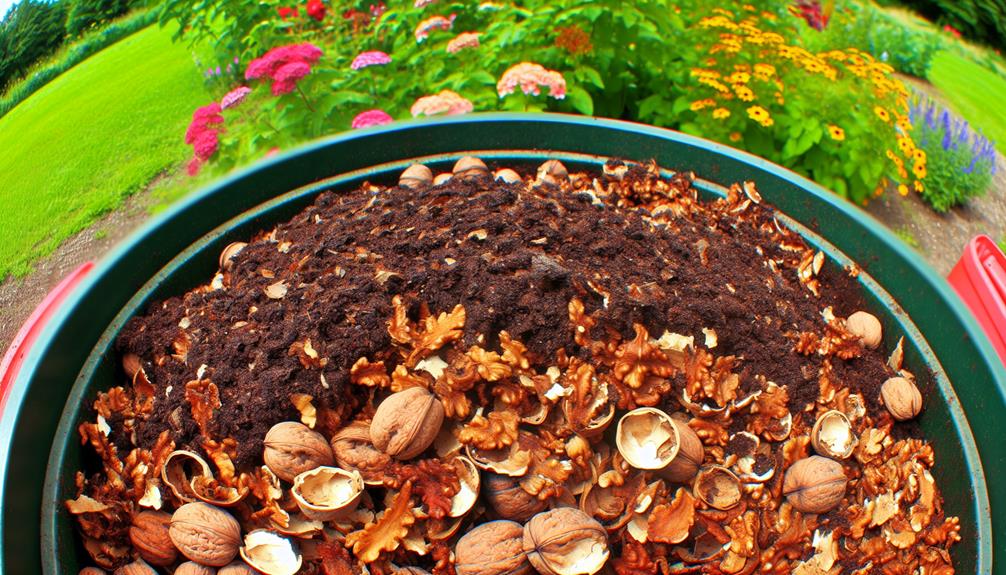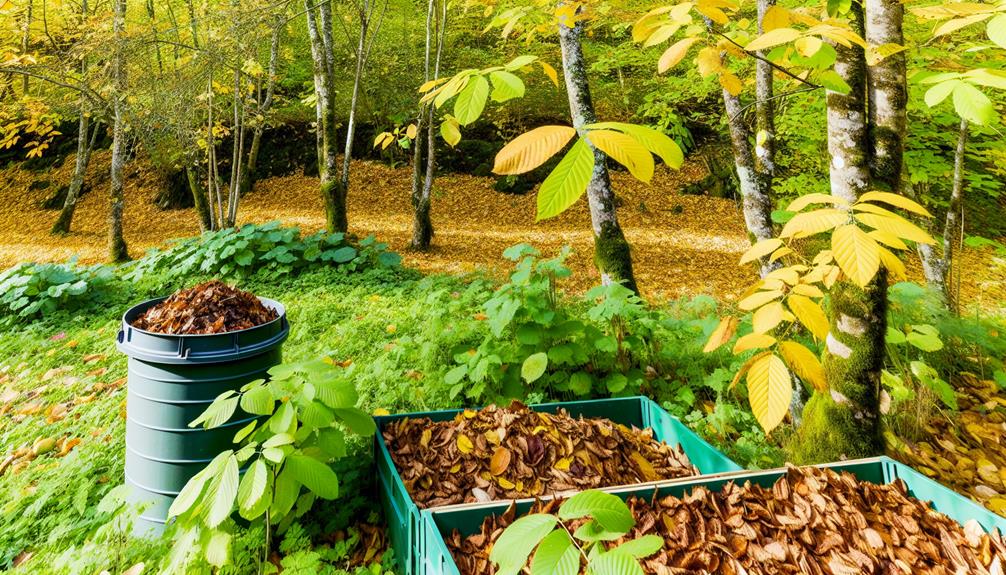

Yes, you can compost walnut, but you need to take precautions due to juglone, a toxin that can harm many plants. To manage this, compost walnut materials separately, and let them decompose for at least a year. Shred walnut leaves for faster breakdown and mix them with other organic matter.
Walnut shells decompose slowly, so crush them to speed up the process and improve aeration. Regularly turn and aerate the compost pile to promote juglone breakdown. Keep in mind to avoid using walnut compost on juglone-sensitive plants like tomatoes and peppers. Want to make sure compost safety and best decomposition?
When composting walnuts, you need to understand juglone toxicity and its potential impact on other plants. Juglone is a chemical compound found in walnuts that can be harmful to many types of plants. It’s important to be aware of how juglone breaks down in the composting process and to know which plants are sensitive to it.
The breakdown of juglone happens over time, but it can take up to a year or more for the toxicity to diminish considerably. During this period, any compost containing walnut materials can harm juglone-sensitive plants. These include tomatoes, peppers, potatoes, eggplants, and some flowering plants like azaleas and rhododendrons.
If you have these plants in your garden, it’s best to avoid using compost that contains walnut remnants until you’re certain the juglone has fully broken down.
To help juglone break down more rapidly, make sure your compost pile is well-aerated and turned regularly. This promotes microbial activity, which aids in the decomposition process. Additionally, consider using a separate compost bin for walnut materials to prevent cross-contamination with your other compost. This way, you can safeguard your garden and ensure healthy, thriving plants.
Also Read: Can You Compost Bones?
Don’t overlook the role walnut shells play in composting, as they can be both beneficial and challenging. Walnut shells are tough, which means their shell decomposition takes time. However, their gradual breakdown can still offer several advantages to your compost pile. They contribute essential nutrients and help improve the compost’s structure.
To better understand how walnut shells interact in your compost, consider the following table:
| Aspect | Details | Tips |
|---|---|---|
| Decomposition Rate | Slow | Crush shells to speed up breakdown |
| Nutrient Contribution | Adds minerals like potassium | Combine with other rich organic matter |
| Soil Aeration | Improves as shells break down | Turn compost regularly |
| pH Balance | Generally neutral | Monitor pH levels |
| Water Retention | Enhances as shells decompose | Maintain balanced moisture |
Crushing the shells can aid in faster shell decomposition, making it easier for microorganisms to do their work. Walnut shells also provide good aeration, preventing your compost from becoming too compacted. They contribute minerals like potassium, which are beneficial for plant growth.
As part of your composting community, embracing walnut shells can enhance the overall quality of your compost. Just remember to balance them with other organic materials to optimize nutrient contribution and decomposition rates. So, don’t hesitate to include those walnut shells in your compost pile!
Also Read: Can You Compost Blood?
Composting walnut leaves can be a bit tricky due to the presence of juglone, a natural compound that can inhibit the growth of certain plants. You might worry, but don’t fret—there are ways to manage this.

First, guarantee proper leaf breakdown by shredding the leaves before adding them to your compost pile. This speeds up decomposition and helps reduce the juglone’s impact.
Here are some composting tips: mix walnut leaves with other types of organic matter like grass clippings, kitchen scraps, and non-walnut leaves. This dilution helps lessen the juglone concentration.
Turn your compost heap regularly to aerate it, which accelerates the breakdown process and further diminishes juglone’s potency.
To ensure your compost is safe for your garden, let it mature fully. This usually takes about a year. During this period, the juglone will degrade and pose less risk to sensitive plants.
Keep an eye on your compost’s moisture level; it should be as damp as a wrung-out sponge. If it’s too dry, water it; if it’s too wet, add dry materials like straw or shredded paper.
Implementing safe composting practices guarantees that your compost is both effective and beneficial for your garden. Start by adhering to basic composting guidelines. Make sure your compost pile includes a balanced mix of green materials like vegetable scraps and brown materials like dried leaves. This balance ensures a healthy decomposition process.
When dealing with walnut compost, safe handling is important. Walnut leaves and shells contain juglone, a compound that can be toxic to certain plants. To minimize risks, compost walnut materials separately and allow them to decompose thoroughly before using the compost in your garden. This process can take up to a year, but it reduces juglone levels significantly.
Keep your compost pile aerated by turning it regularly. This not only speeds up decomposition but also ensures harmful compounds break down more effectively. Monitor the moisture content, aiming for a consistency similar to a wrung-out sponge. Too much moisture can cause anaerobic conditions, while too little can halt decomposition.
Lastly, always wash your hands after handling compost materials. While composting is a natural process, it’s important to practice safe handling to avoid any potential health risks.
Also Read: Can You Compost Black-Eyed Peas?
When you compost walnut materials properly, you’ll find both significant benefits and some potential drawbacks worth considering. One major benefit is the improvement in soil fertility. Walnut compost can enrich your soil with essential nutrients, making it more productive for your garden.

Additionally, walnut materials have a moderate decomposition rate, which means they break down at a steady pace, providing a consistent release of nutrients over time.
However, there are some drawbacks to be mindful of. Walnut trees produce a natural chemical called juglone, which can be toxic to certain plants. If not managed carefully, compost containing walnut materials can harm sensitive plants in your garden. It’s important to make sure that the composting process thoroughly breaks down the juglone to neutralize its effects.
Moreover, walnut shells are quite hard and take longer to decompose, potentially slowing down the overall decomposition rate of your compost pile. To mitigate this, you can crush or shred the shells before adding them to your compost.
You can compost other types of walnuts, but be cautious with black walnuts. Their juglone toxicity can harm plants. Consider composting walnut leaves separately to avoid issues. We all want a thriving garden, right?
You’re wondering how long walnut components take to decompose in compost. With proper temperature control and active microbial activity, it usually takes 6-12 months. Join your composting community and share tips for faster decomposition!
For walnuts, prioritize nutrient balance by mixing them with nitrogen-rich materials. Use aeration techniques like turning the pile regularly. You’ll help your community compost effectively, creating rich soil everyone can benefit from.
You’ve got to be careful with walnut toxins. Not all plants can handle them. Before you use composted walnut materials, check plant compatibility. Your garden community will thrive when you match the right plants with the compost.
Yes, walnut shells can attract pests and rodents in your compost pile. However, you can use pest deterrents and effective rodent control methods to keep your compost healthy and your garden community thriving.
You can compost walnut materials, but you need to be cautious. Juglone toxicity from walnut trees can harm certain plants.
To safely compost walnut shells and leaves, make sure they’re well-aged and decomposed. Use separate piles for walnut compost and monitor the breakdown process carefully.
This method minimizes risks, allowing you to utilize walnut compost effectively. Following these guidelines, you’ll reap the benefits while avoiding potential drawbacks in your garden.
